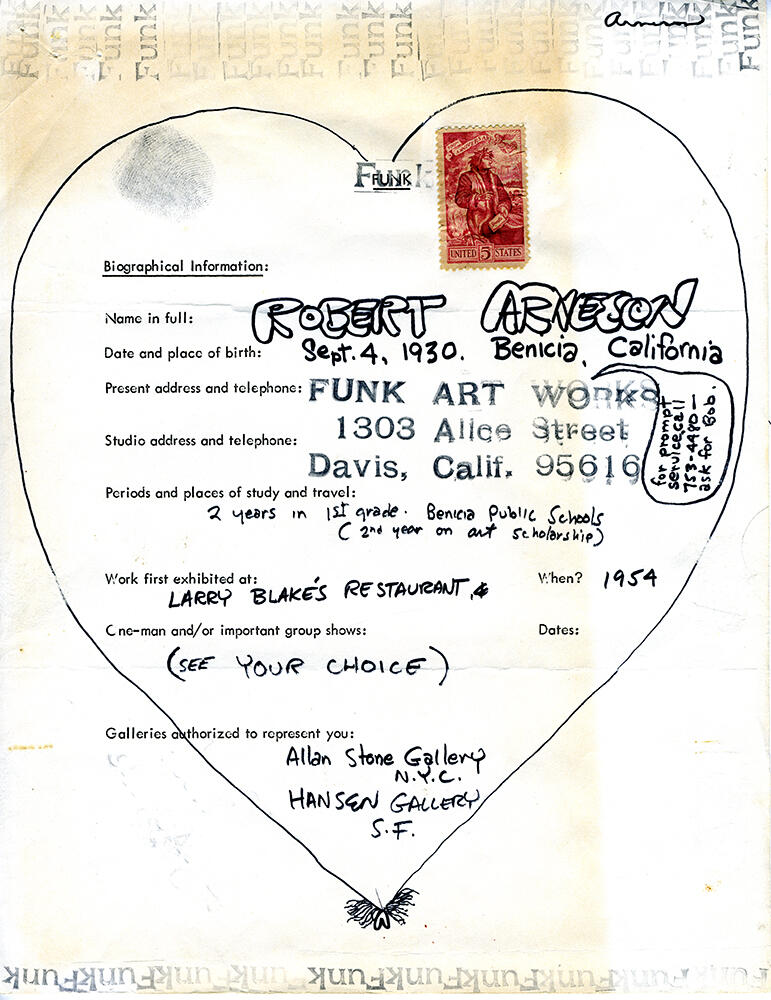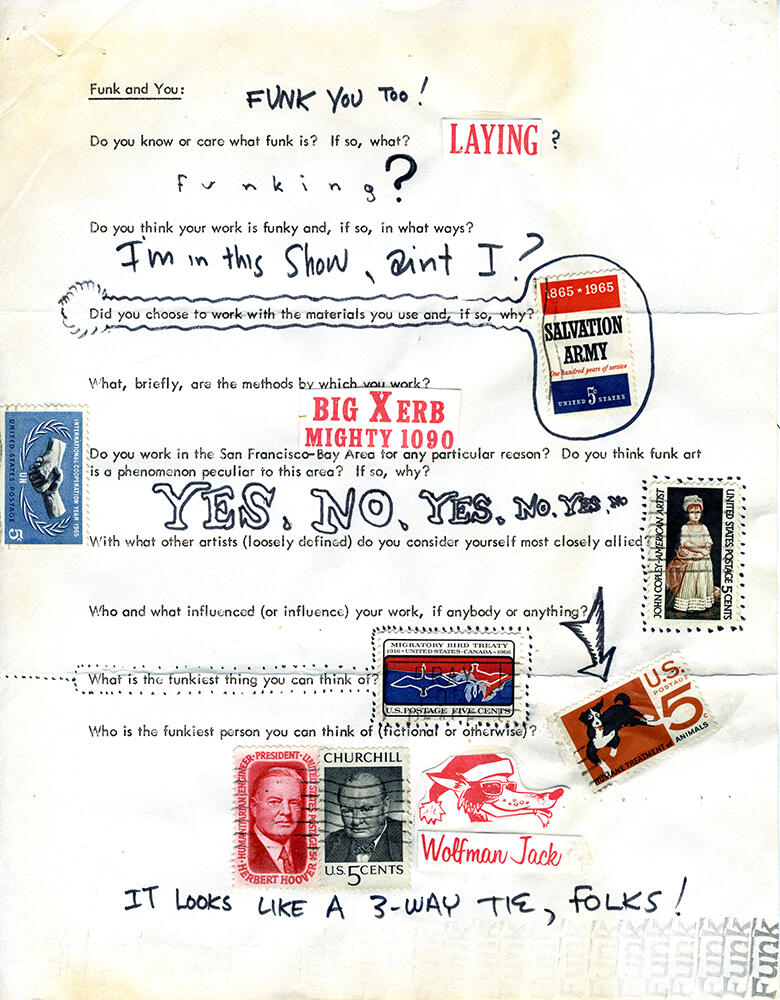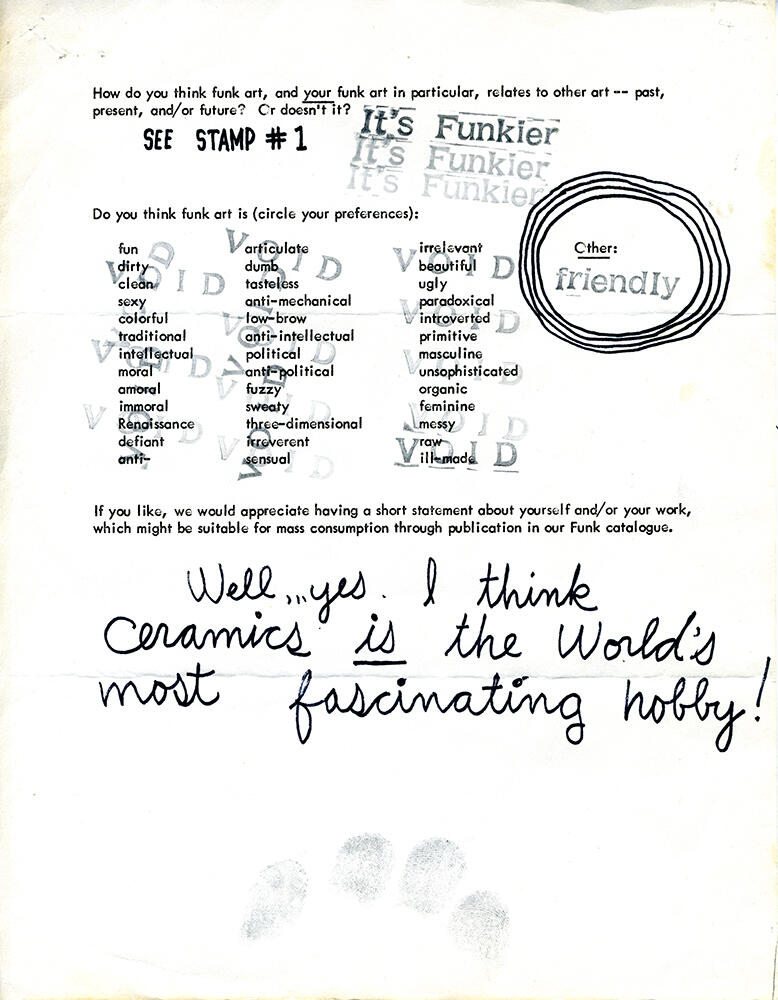As part of his research for the 1967 exhibition Funk, held at the Berkeley Art Museum, curator Peter Selz distributed a survey-style questionnaire to many of the artists later featured in the exhibition. While a significant amount has been written about the Bay Area Funk art movement1 , much of that writing—and that which sporadically continues—focuses on the emergence, vilification, verification, and ambivalence surrounding the 1967 exhibition and the use of the name Funk itself.
The Funk Questionnaire though, remains a bit of both a mystery and an oversight. In asking artists such as Joan Brown, Robert Arneson, Jeremy Anderson, Roy De Forest, Robert Hudson, Peter Saul, and others questions like Do you know or care what funk is? If so, what? What is the funkiest thing you can think of? Do you think your work is funky and, if so, in what ways?2 , Selz betrayed his ambition to solidify and codify an art movement. This was a gesture intended to establish him as a visionary curator and museum director, but it risked alienating the very artists he sought to prop up.
The Funk Questionnaire’s mildly sarcastic, pleadingly desperate tone betrays Selz’s, and many curators’, naïve desire to be part of an art movement and in some ways one of the artists. The completion of the documents, and in particular that by Robert Arneson3 , in most cases became less an act of information sharing and more one of ambivalent creativity4 . Arneson’s questionnaire is perhaps the most unabashedly humorous, oblique, and inspired of the submissions Selz received.
Arneson answered many of the questions by pasting U.S. postage stamps in the margins or by writing derisive and evasive answers such as a string of the words Yes, No, Yes, No in large capitalized bubble letters. At the top of the survey, Selz included the heading “Funk and You,” to which Arneson responded “Funk You Too!,” alluding to Funk as an action perhaps not dissimilar to the expletive in which the n is replaced with a c. Arenson’s answers, in their bombast and confrontational manner, seem to encourage Selz, further reinforcing and perhaps foregrounding the definition of Funk art he would issue in the 1967 exhibition catalogue: “Funk art is hot rather than cool; it is committed rather than disengaged; it is bizarre rather than formal; it is sensuous; and frequently it is quite ugly and ungainly.” 5 When examined closely, surveys by Arneson and the other Funk artists support (more than they object to) Selz’s classification of their work as Funk art. The surveys as primary source documents provide a glimpse into not only the research phases of exhibition making, but in some small way shed light on the very formulation of an art-historical classification as it was being constructed through artist-to-curator and curator-to-artist communication.
In some ways it is curious that the questionnaires were returned at all. Wouldn’t not answering or failing to return the document have been the most radical moves of all? Perhaps not. Maybe an eloquently composed disagreement in response to Selz’s ideas would have made the strongest statement. One begins to wonder what Selz would have done if he received a treatise against the Funk label, or if he hadn’t received a single response.
Many of the artists featured in the 1967 Funk exhibition, and many of those left out, were displeased with its thesis, but Selz’s definition, one greatly shaped by a document, the Questionnaire, that initially seems purely anecdotal and perfunctory, offers remarkable clarity for and insight about the art being made in Northern California in the 1960s and 1970s.
A. Will Brown
Curatorial Assistant, Contemporary Art
- 1See the following: Peter Selz, “Robert Arneson in the ’60s,” Sculpture Magazine, January/February 2009, accessible at http://www.sculpture.org/documents/scmag09/janfeb_09/arneson/arneson.shtml; Roula Seikaly’s “Thoughts on a hot, committed, bizarre, sensuous, ugly, and ungainly form of art” in Art Practical, 2013 (http://www.artpractical.com/feature/funk/); Thomas Albright, Art in the San Francisco Bay Area, 1945–1980: An Illustrated History (Berkeley: University of California Press, 1985); Nicole Rudick, “Funk,” in What Nerve!: Alternative Figures in American Art, 1960 to the Present, edited by Dan Nadel and Judith Tannenbaum (New York: d.a.p. and RISD Museum, 2014); Barbara Engelbach, Friederike Wappler, and Hans Winkler, Looking for Mushrooms: Beat Poets, Hippies, Funk, Minimal Art : San Francisco 1955–68 (Köln: Museum Ludwig, 2008).
- 2Robert Arneson’s Funk Questionnaire in Nadel and Tannenbaum, 144–46.
- 3Ibid.
- 4Peter Saul’s and Jeremy Anderson’s questionnaires answer Selz’s questions in detailed fashion and with what appears to be less ambivalence and more of an embrace, or at least an interest in, what Selz was trying to accomplish by distributing these documents. See Nicole Rudick in Nadel and Tannenbaum, 140–43 and 166–68.
- 5Peter Selz, Funk (Berkeley: University of California, 1967), 3.


